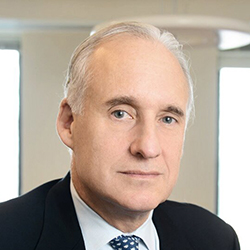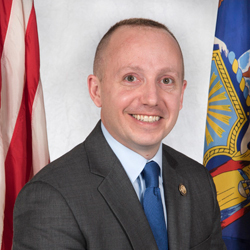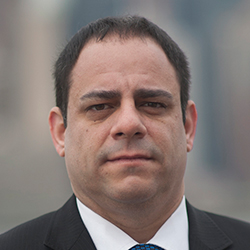On Earth Day a year ago, President Barack Obama hailed a landmark international agreement to “set the world on a path to a low-carbon future.” Nearly 200 countries had agreed during talks in Paris to substantially reduce carbon emissions, and representatives from around the world were in New York to sign the agreement, which was aimed at combating global warming.
“The Paris Agreement demonstrates what is possible when the world is united by a common concern and a shared purpose,” Obama said in his annual Earth Day proclamation. “The Agreement sets ambitious and specific targets for each nation that are necessary to solving the climate crisis.”
On this year’s Earth Day, which falls on Saturday, April 22, the tone has shifted dramatically. Before he was elected president, Donald Trump called global warming a hoax “created by and for the Chinese in order to make U.S. manufacturing non-competitive.” Last month, he signed an executive order to roll back Obama-era environmental regulations, reversing the country’s commitments to combat climate change. Environmental Protection Agency Administrator Scott Pruitt, who is tasked with carrying out Trump’s order, has even expressed support for eliminating the agency he now runs.
In response, states like New York and California have pledged to push back against the federal administration and are redoubling efforts to promote more environmentally friendly energy policies. In the following interviews, we look at the some of challenges New York officials face as the state balances its investment in renewables, like solar and wind, with new subsidies for nuclear power.
RELATED: Cuomo needs New York to step up its solar act
Richard Kauffman
Chairman of Energy & Finance for New York
C&S: Gov. Andrew Cuomo’s Reforming the Energy Vision program is still ongoing. What progress has been made and have there been any new developments?
RK: Gov. Cuomo’s Reforming the Energy Vision strategy includes a number of initiatives supporting the transformation and modernization of a cleaner, more resilient and affordable energy system for all New Yorkers. REV’s impact can already be felt in communities across New York from Buffalo to New York City to Montauk. Some of the initiatives at the forefront of the state’s efforts include NY-Sun, which has led to solar (power) increasing by nearly 800 percent between 2011 and 2015; a community microgrid competition to keep the lights on and critical services available in communities in an extreme weather event; a $5 billion Clean Energy Fund dedicated to the state’s evolving clean energy and innovation initiatives; the Drive Clean Rebate initiative to encourage and increase electric car use and car charging infrastructure; and new methods to create fairer and more accurate prices in order to develop more solar, wind and other “distributed energy resources,” or energy produced on the customer’s site.
C&S: Are there any potential grid reliability challenges the state’s energy grid may face due to the Indian Point nuclear power plant shutdown?
RK: The state has been planning and preparing the electric system for Indian Point’s eventual closure for many years. In 2013, the Public Service Commission approved the Indian Point Contingency Plan, which has already resulted in nearly half of Indian Point's capacity being replaced by enhanced transmission and energy efficiency measures. As a direct result of the comprehensive planning for Indian Point’s closure, the loss of the plant will have a negligible or no adverse bill impact on customers.
Independent analyses have confirmed that Indian Point’s power can be adequately replaced with minimal consumer impact by resources that are already in service or permitted and more that will come online through the Clean Energy Standard. The development of energy efficiency and demand-based resources, in combination with transmission upgrades, means both that the need for replacement supply has decreased and that the state can take better advantage of existing upstate resources, making it easier to get power from where it is produced in those regions to areas of greater demand downstate.
C&S: Cuomo’s nuclear power plant bailout has received much criticism. What can the state do to address concerns about the significant funding involved and why does the Cuomo administration believe this is a necessary move?
RK: The state is fully committed to developing an energy system that is cleaner, and more resilient and affordable for all New Yorkers.
Had the upstate nuclear plants closed earlier this year as threatened, due to low natural gas prices, we know that dirtier, fossil fuel sources would have replaced the emissions-free energy now produced by these plants. We could not feasibly or economically replace 3,200 (megawatts) worth of baseload nuclear power capacity with renewable energy overnight. Nuclear power thus serves as a temporary but critical bridge as the state advances its State Energy Plan goals, including 50 percent of the state’s electricity coming from renewables by 2030 and a 40 percent reduction in greenhouse gas emissions by the same time. In short, we must protect the environmental and health benefits of all New Yorkers who are already benefiting from these plants by preventing any backsliding in reducing the state’s carbon footprint and continuing our fight against climate change.
It is crucial to also understand that taking no action and allowing the upstate nuclear facilities to close prematurely would cost residential ratepayers $7 a month (an approximate 6 percent bill increase) compared to less than $2 a month for the Clean Energy Standard. For a typical residential customer in (New York City using about 300 kWh of electricity per month), the bill impact will be only $0.98 per month. And we all win with cleaner air and power.
RELATED: D.C. provides reason to support New York's renewable initiatives
Basil Seggos
Commissioner, New York state Department of Environmental Conservation
C&S: The DEC released a report on some of the failures of dredging the Hudson River and the river might need to be dredged again. What are your thoughts and do you believe it is necessary?
BS: Late last year, DEC called on the (U.S. Environmental Protection Agency) to expand its PCB (polychlorinated biphenyl) investigation to the lower Hudson (River) and to conduct additional sampling to ensure legitimate Hudson River PCB cleanup. Our independent analysis finds EPA’s Hudson River cleanup fails to protect public health and the environment. We found high PCB sediment concentrations will remain after dredging, indicating that the targeted reductions in fish PCB concentrations required by (the) EPA will not be achieved in the time frames EPA relied upon when choosing the remedial plan for the Hudson River. With such a significant amount of contamination being left behind, New York state cannot find the remedy effective. New York state is calling on the EPA to finish the job and hold (General Electric) accountable for cleaning up the Hudson River. If (the) EPA won’t do the job and protect New Yorkers and the environment, DEC is ready to step in and lead.
C&S: After the water contamination at Hoosick Falls, what can the state do to prevent future water contamination?
BS: Protecting drinking water is one of the governor’s top priorities. To ensure that current and future New Yorkers have access to clean water, the budget initiates the $2.5 billion Clean Water Infrastructure Act. This transformational investment will protect public health, safeguard the environment, and preserve the state’s water resources. These funds will help local governments address water emergencies, pay for local infrastructure construction projects, underwrite land acquisition for source water protection and investigate and mitigate emerging contaminants in drinking water. These projects will improve the quality and safety of municipal drinking water distribution, filtration systems, and wastewater treatment infrastructure.
At the governor’s direction, the Water Quality Rapid Response Team is developing the nation's leading water quality program and implementing comprehensive actions to address water quality issues. The team is tackling matters ranging from currently regulated contaminants, such as lead, to emerging contaminants like perfluorooctanoic acid. The team is also reviewing and incorporating the best available science and may review standards for currently unregulated contaminants, enhanced testing and oversight of drinking water systems, including private wells, and state-of-the-art drinking water treatment options.
Catherine McCabe
Acting Regional Administrator, Region 2, U.S. Environmental Protection Agency
C&S: President Donald Trump has proposed a 31 percent budget cut to the EPA. What is your No. 1 priority in New York that you would not allow to be affected by budget cuts?
CM: We are in the early stages of a long budget process and final funding levels will not be settled until Congress acts. The agency will work with Congress as they review the president’s request. EPA has an important core mission to protect human health and the environment, and we all are focused on carrying out that mission.
In New York, some of our top priorities include cleaning up the many Superfund sites throughout the state, such as the Gowanus Canal, and working with New York state to address sites that pose immediate threats, such as our work with (the New York state Department of Environmental Conservation) at Morgan Materials in Tonawanda. We are also working closely with our state and local partners to address problems such as nitrogen pollution in groundwater and surface water on Long Island, and will continue the progress that we have made toward attaining air quality standards in New York.
C&S: You’ve spent most of your career in public service, working at the U.S. Department of Justice for 22 years and the EPA for more than a decade. Do you hope to stay with the EPA under the new president?
CM: I certainly plan to continue doing the job that I love and have dedicated my career to. As a career employee of the EPA, I plan to serve as acting regional administrator for Region 2 until a new regional administrator is named. After that I expect to go back to my prior position of deputy regional administrator. I will soon become a first-time grandmother, so of course part of my plan will be to spend time with my grandchild. I am incredibly thankful for the opportunities I’ve been given.
RELATED: How will New York replace Indian Point?
Costa Constantinides
Chairman, New York City Council Committee on Environmental Protection
C&S: What will your committee be focusing on, and what do you hope it can accomplish before the end of the term?
CC: We’re really focused on calling out a federal government that is scaling back environmental protections and legislation. And our priority is, like we did just (recently), passing the most comprehensive environmental justice law of any city in the country. (The councilman was referring to legislation sent to the mayor that would require the city to map pollution, health impacts and the environmental impact of city policies in areas with large low-income populations or communities of color, and issue recommendations to address concerns.) We are looking to try to stop power plants in our communities from burning (fuel oil grade No.) 6 and 4 for the next 13 years. So we are going to be pushing, on April 24, Intro. 1465, in partnership with Council member (Ritchie) Torres. We are going to be working on continuous renewable energy. And looking at, again, how to make it easier for renewable energy to be part of the lexicon New Yorkers use every day in their homes because there is a lot of red tape, and making it as easy to be green as it is to be traditional is really important.
C&S: What will you be looking for in the upcoming progress report on the OneNYC plan?
CC: We have a shared goal of reducing emissions 80 percent by 2050. We know that we have to deal with buildings, which are 70 percent of the greenhouse gas emissions in New York City. So how we tackle buildings is going to be a huge challenge.
C&S: What’s your sense of how the mayor’s green jobs plan will work?
CC: When I heard it proposed, at the State of the City, it seemed like an idea that was needed. I agree with the mayor that training men and women in the city of New York for the jobs of the 21st century is what needs to happen. I’m going to be, of course, following (it) very closely throughout our budget process.
Vincent Sapienza
Acting Commissioner, New York City Department of Environmental Protection
C&S: The borough presidents have raised concerns about lead levels in the water at some schools, and how the schools have been handling it. Is the city comfortable with current protocols for handling high lead level detections? How, if at all, is it considering changing protocols?
VS: New Yorkers should rest assured that our tap water is of the highest quality. In fact, DEP conducts over 500,000 tests every year to ensure that the water meets or exceeds all state and federal health standards.
In addition to DEP’s extensive work, the Department of Education is also conducting citywide testing in schools. Any drinking or cooking outlets that exceed the 15 parts per billion action level are immediately taken offline, remediated and not placed back into service until the outlet retests below the action level. Last fall, the state issued new regulations on testing water for lead in schools and (the Department of Education) updated its protocol to ensure it continues to exceed all requirements.
There has not been a single case of lead poisoning in NYC connected to the water supply and residents should feel comfortable that the city is taking every precaution to ensure the health and safety of our school children.
C&S: A court prevented the city from implementing its planned water rate schedule and rebate system. How will this influence how the city sets its water rates this spring?
VS: DEP and the Water Board are seeking to appeal the most recent decision. Concurrently, DEP is developing a plan for the Water Board's consideration that would ensure DEP has the funding required to fulfill its critical mission.
NEXT STORY: Solar Czar: A Q&A with NY-Sun’s David Sandbank







